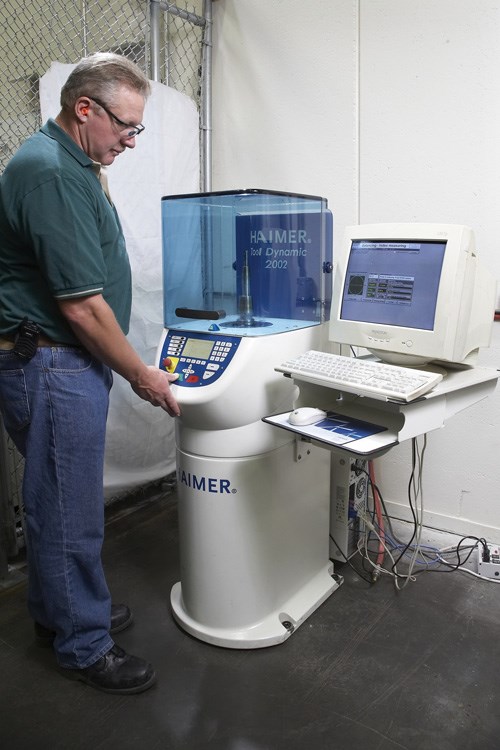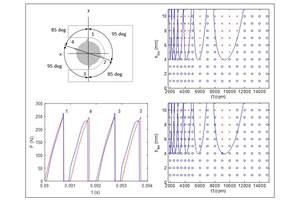Balanced Tool Assemblies Boost Quality, Efficiency
With balancing equipment and shrink-fit toolholders from Haimer USA, this manufacturer of automotive castings improved productivity, accuracy and surface finishes while extending tool and spindle life.
Share





When Warren Hacker joined J.L. French Automotive Castings, the company got more than a new employee. Mr. Hacker, who signed on 4 years ago as the automotive casting supplier’s manager of North America MRO Purchasing, suggested that the company adopt a technology he had used for years at other shops—shrink-fit toolholders and balancing equipment from Haimer USA. The result? Faster throughput, higher accuracy, greater flexibility and improved surface finishes.
J.L. French began making aluminum die castings in 1968 as a small, family-owned business. The company specialized in small engine components for lawn care and marine applications until 1983, when it began work on its first major automotive oil pan program. In 1994, the company opened a facility in Sheboygan, Wisconsin, which features a fully integrated, secondary smelting operation for material quality and cost control. In 1996, the company was sold to Winward Capital, which introduced an aggressive growth plan intended to make the company a global supplier to the automotive industry. Soon after, the company was awarded a major contract to supply automatic transmission cases for light trucks and sport utility vehicles, necessitating a major expansion of the Sheboygan facility for the installation of 3,500-ton die-casting machines.
Today, the company has four plants—two in Sheboygan, one in Glasgow, Kentucky and one in Spain—as well as 14 engineering/customer service offices around the world. The company provides customers with services including product design, simulation, testing, rapid prototyping and production. It designs, produces and assembles oil pans, engine front covers, transmission cases, bedplates, cam caps, brackets and engine blocks found on various automotive platforms. Components produced on its die-casting machines range in weight from a few grams to 22 kilograms, and 80 percent of those components are machined at both high and low speeds.
Mr. Hacker says J.L. French uses the Haimer shrink-fit toolholders and balancing equipment primarily for tools mounted in its HMCs and VMCs as well as machines for special, proprietary applications. "It’s relative to the application," he explains. "Shrink-fit and balancing have become our standard of operation. I use a lot of hollow mills, and I balance them even at lower speeds."
This last point is notable because the company has found balancing to be beneficial not just for high speed applications, but for lower speeds as well. Many applications involve multitasking and cartridge tools, which were previously run at about 500 rpm. The Haimer equipment allows the same tools to run at 3,000 rpm—6 times faster—with an associated increase in feed rates.
Haimer’s balancing and shrink-fit products allow the company to machine not only faster, but also more accurately. They also improve tool life and surface finish. Unbalance is caused by uneven weight distribution during rotation, and the resulting vibration is transferred throughout the cutting tool and the entire machine. This can reduce spindle and tool life, deteriorate surface finish and create undesirable cutting conditions. Using a balancing machine to reduce vibration helps the company avoid these issues. Additionally, shrink-fit systems exert a uniform clamping force around the tool’s shank to securely grip it in the holder. This improves the toolholder assembly’s rigidity, concentricity and balance, reducing runout and improving accuracy and surface finish.
While pre-balancing the toolholder can be beneficial, obtaining the performance increase mentioned above requires balancing the entire assembly. That’s why J.L. French waits until the full toolholder assembly is complete before finishing the balancing process. A set-screw hole, a standard option on Haimer’s shrink-fit holders, enables operators to balance assemblies in minutes by simply adding a set screw.
Shrink-fit and balancing technology is especially helpful when using long extensions to machine complex castings. Like the toolholders, these extensions grip tools via a heat-shrink process. Balancing the extensions, some of which are as long as 12 to 14 inches, enables the company to obtain penetration rates equal to those achievable with standard-length tooling, Mr. Hacker says. "The extensions in the holder wouldn’t allow us to run at these rates without balancing," he explains. "We’d have problems with hole location."
In some applications, the company uses the extensions along with an extended shrink-fit toolholder. Using both enables cutting features that would be otherwise inaccessible. This can enable cutting parts complete in a single setup, reducing cycle and lead times for additional operations.
Mr. Hacker says another notable benefit of shrink-fit tooling is that it is easy to maintain. "With a collet system, dirt, coolant and all kinds of things can get in there. You have to take it apart, clean and carefully reassemble the toolholder. With heat-shrink, that’s not the case."
The shrink-fit and balancing equipment’s ease of use and support from Haimer USA’s technical staff made implementing this technology simple, and the investment has paid off, Mr. Hacker says. "We do a lot of things tooling-wise that are out of the box—things I know we couldn’t do without shrink-fit and balancing technology."
Related Content
How to Mitigate Chatter to Boost Machining Rates
There are usually better solutions to chatter than just reducing the feed rate. Through vibration analysis, the chatter problem can be solved, enabling much higher metal removal rates, better quality and longer tool life.
Read MoreThe Impact of Cutting Teeth Spacing on Machining Stability
Many cutter designs are available, and variable teeth spacing (or variable pitch) cutters can be used to influence milling stability. Let’s discuss why teeth spacing affects stability.
Read MoreQuick-Change Tool Heads Reduce Setup on Swiss-Type Turning Centers
This new quick-change tooling system enables shops to get more production from their Swiss turning centers through reduced tool setup time and matches the performance of a solid tool.
Read MoreToolpath Improves Chip Management for Swiss-Type Lathes
This simple change to a Swiss-type turning machine’s toolpath can dramatically improve its ability to manage chips.
Read MoreRead Next
Registration Now Open for the Precision Machining Technology Show (PMTS) 2025
The precision machining industry’s premier event returns to Cleveland, OH, April 1-3.
Read MoreBuilding Out a Foundation for Student Machinists
Autodesk and Haas have teamed up to produce an introductory course for students that covers the basics of CAD, CAM and CNC while providing them with a portfolio part.
Read MoreSetting Up the Building Blocks for a Digital Factory
Woodward Inc. spent over a year developing an API to connect machines to its digital factory. Caron Engineering’s MiConnect has cut most of this process while also granting the shop greater access to machine information.
Read More























.png;maxWidth=300;quality=90)












